19 Jun Papua New Guinea — Intruding on the Huli Wigman
People have been in the Highlands of Papua New Guinea since the memory of man runneth not to the contrary. Fifty-five, sixty-thousand years, maybe. Longer than anywhere else outside of Africa. For most of that time, as far as anyone knows, the Huli Wigmen have lived on the same jungly mountaintop

but, then, nobody knows very far.
The Huli have a reputation for being warlike, but that may have something to do with the way they were introduced to the outside world. In 1934, fifty were gunned down by gold prospectors. There are probably oral traditions explaining what happened, but Peg and I never heard them from either side, so we don’t know the particulars. Other than that, the Wigmen are just one more Papuan tribe that outsiders wouldn’t think much about . . . if it weren’t for the striking figures they cut in their wigs and painted faces.
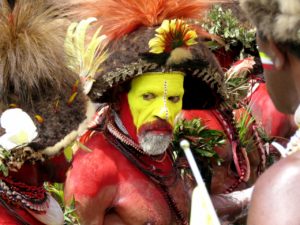
The wigs are a guy thing, and the product of one of the most extended coming-of-age rituals since Ancient Sparta. Starting at 14 or 15, boys move into the second floors of spirit houses
.
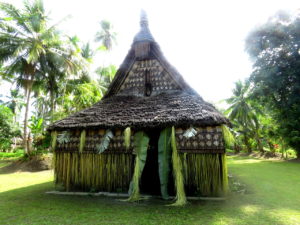
.
where they’re forbidden any contact with women so that their their dads can fill them in the on ways of men. Given how long those boys spend up there they must require a lot of filling in. Also, it gives them time to cultivate wigs.
Bamboo bands shape their growing hair for eighteen months or so until the first cutting, after which it’s fashioned into what look like sporty versions of

.
toreador hats. Or the floral centerpieces
.
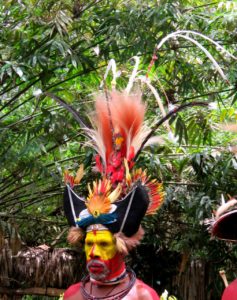
.
at overly-expensive weddings.
After several rounds of hair-growing and wig-fashioning, a newly-minted man emerges . . . boasting a haberdashery of wigs, both formal and everyday . . . and ready to take a wife.
People will tell you that marriage has a civilizing affect on young men but, speaking personally, being locked for months on end in an attic with no access to girls and nothing to listen to but hair growing and lectures from my dad wouldn’t have had an improving affect on me. So, maybe, the stories about Huli being warlike precede their run-in with gold miners.
I have no idea what rituals Huli girls are forced to endure, but a member of our group, having fallen under the sway of ladies in the village, went through some kind of ceremony and returned in

.
local garb.
.
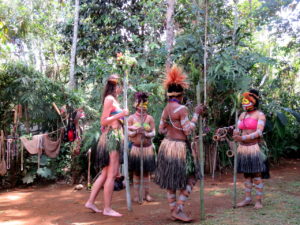
then joined in a dance, looking a good deal more fetching than in the jeans and T-shirt she’d started out in. So, maybe, there’s something to this traditional knowledge after all.
The men danced,
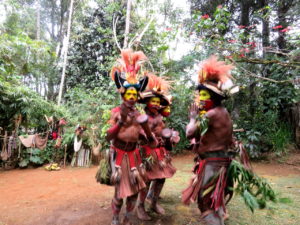
too, but didn’t seem as into it as the ladies, as if the real dances, the ancient rituals and private ceremonies and hard-won wisdom were things they held close for themselves and weren’t for strangers.
There were other people in the village. Shy kids

who gawked at us from the foliage. Or from the shadows between houses when they thought we weren’t looking.

Mothers and children
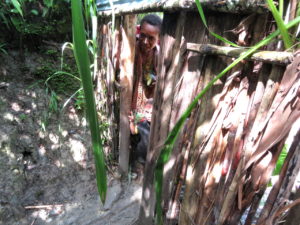
peeking through partially-opened doors suspecting, perhaps, that we might be gold miners.
Of everywhere we poked our noses, the trivial voyeurism of photographing
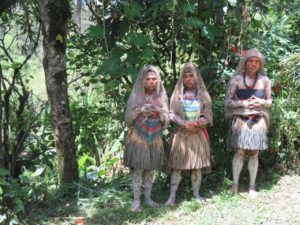
a group of widows posing on the side of the road was the only thing that made me uncomfortable. It was such a personal thing, those ladies displaying their grief for the momentary pleasure of outsiders, like clapping for Sitting Bull in Buffalo Bill’s Wild West Show.
Off around a corner lurked a gate

.
we weren’t supposed to go through until the dances were finished. On the far side

was the wooden crypt where the ancestors resided, their faces painted yellow and red like still-living members of the community. The wood wasn’t going to last long, not in the jungle. And, when it went, the ancestors would disappear into the New Guinea soil along with it.
That evening it rained and the men
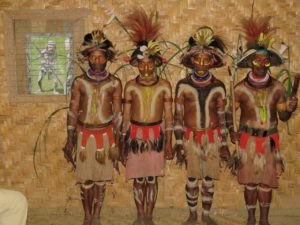
.
danced indoors.
In the dim light they were difficult to discern against the woven bamboo wall, as if they, too, were fading into the past along with their ancestors.
.


No Comments